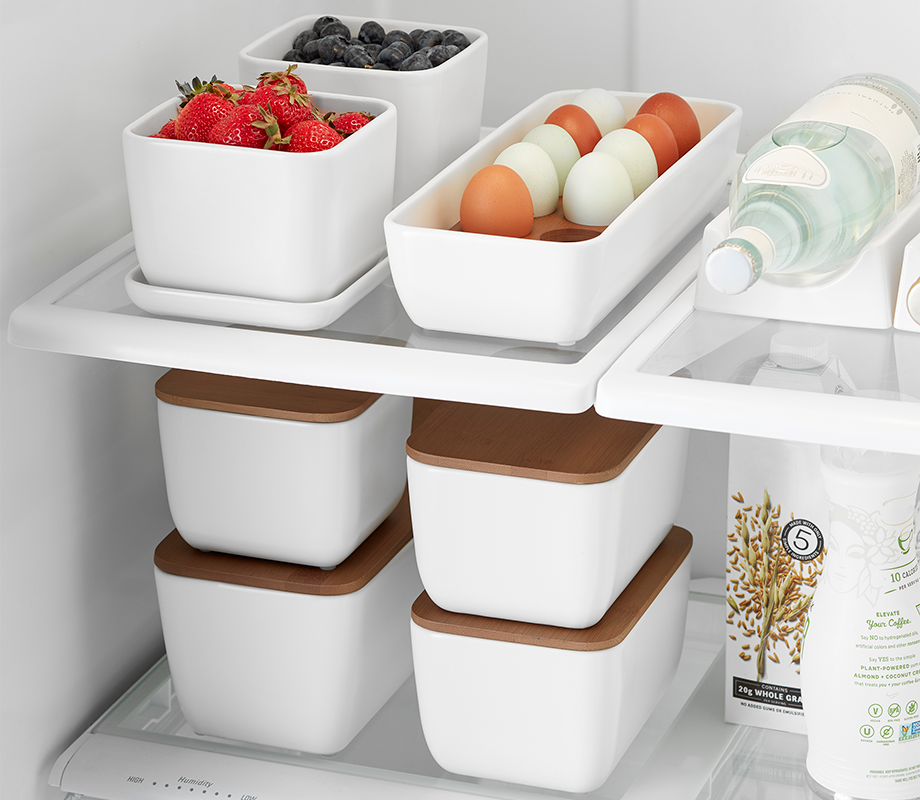How to Organize a Refrigerator

- Tip 01Toss Expired Items
- Tip 02Perform a Joy Check
- Tip 03Store Like With Like
- Tip 04Arrange By Height
- Tip 05Label and Date Leftovers
- Tip 06Freeze Stock Scraps and Your Compost
- Tip 07Don’t Over Stock

Did you know that the average person opens their refrigerator 15-20 times daily? Considering how much time we spend looking inside, if those shelves aren’t tidy and organized, they wear us down.
Much like a tidy pantry, an organized fridge will save you time, money, and energy in all aspects of the cooking process: grocery shopping, preparing meals and storing (and remembering to use!) leftovers. Here is how Marie Kondo recommends organizing a fridge once and for all.
Toss Expired Items
Start with a blank slate. It’s easiest to take everything out before organizing the fridge, just don’t leave items out for too long! Check the expiration dates and throw away anything past its prime or comfort level. Some items — pasta sauces, for example — should be discarded three to four days after opening, while others, like salad dressings, olives and pickled vegetables, are safe to use for several months.
Tidy tip: When in doubt, look up your item on a food expiration date chart.
Perform a Joy Check
Perhaps some items in your fridge have not yet expired but haven’t caught your attention in quite some time. Consider whether such ingredients spark joy when you eat or cook with them — or determine whether you plan to use them soon. If the answer is no, these items can be donated or discarded. If you think you will honestly use them, move them to an area of your fridge where they are easily visible and plan to experiment with adding them to a meal in the next week or so.
Additionally, you may wish to use this opportunity to determine which of your items do and do not conform with your current eating habits — or the eating habits of your ideal lifestyle. Take it upon yourself to part with food products that do not support your current goals or well-being. Thank them for their service and move forward.
Store Like With Like
Now for organizing your fridge, shelf by shelf. Keep meats and cheeses separate from fruits and veggies — using the drawers or shelves built into your fridge or refrigerator-safe containers, which are useful for corralling items. This will help streamline the food preparation process, no matter how simple or complex a meal is.
When it comes to the vegetable crisper drawer, there’s an excellent reason for storing like with like: Fruits benefit from the low humidity setting, whereas leafy greens and other thin-skinned vegetables benefit from the high humidity setting. Fruits such as apples and peaches let off ethylene gas as they ripen, which can damage sensitive produce. If you have two crisper drawers, use one for fruits and one for veggies with the appropriate high and low settings. If you have only one drawer with no setting options, it’s automatically high humidity. Store your veggies in there and put fruits on a shelf elsewhere in the fridge.
Organizing a fridge by category will also come in handy before your next trip to the grocery store. When you can see all your items at a glance, you will be quickly reminded of what you do and don’t need to replenish within a specific subcategory.
Arrange By Height
Here’s another key refrigerator organizing idea: When putting items back on your refrigerator shelves, place shorter items toward the front and taller items further back. This will allow you to see everything available when you open the refrigerator. Once again, whether you’re grabbing a quick snack or about to begin cooking a large, multi-course meal, you will be grateful that all the ingredients you need are in view.
Label and Date Leftovers
Cut down on food waste by labeling leftovers with a date. This is particularly helpful for
anything you decide to freeze. Transfer leftovers into appropriately sized jars or containers as you use them rather than leaving them in larger, mostly empty containers. This has two benefits: it cuts down on air exposure to the ingredient, keeping it fresh longer, and it frees up space in your fridge.
Freeze Stock Scraps and Your Compost
Here’s another trick for both an organized and sustainable refrigerator: save bones, onion ends and other vegetable scraps in a labeled bag in your freezer to make stock. You can also store a small compost bin or bag in your freezer until collection day or for use in your garden. Freezing compost keeps the kitchen smelling tidy!
Don’t Over Stock
Whether you want to limit grocery store trips down the line or take advantage of sale prices, it can be tempting to stock up on items that can be stored unopened in the refrigerator for months. However, such purchases often add unnecessary clutter to your fridge and may distract you from what you need to use up.
Abstain from purchasing extras when possible. Always set aside some open space on the shelves in your fridge — in fact, plan to keep about 30 percent of the space empty. This will simplify the process of storing leftovers.
Resist the urge to put things away quickly and dedicate your energy toward keeping this new system in place. When you can easily navigate the contents of your fridge, you will save time each day — and save money in the long run.







